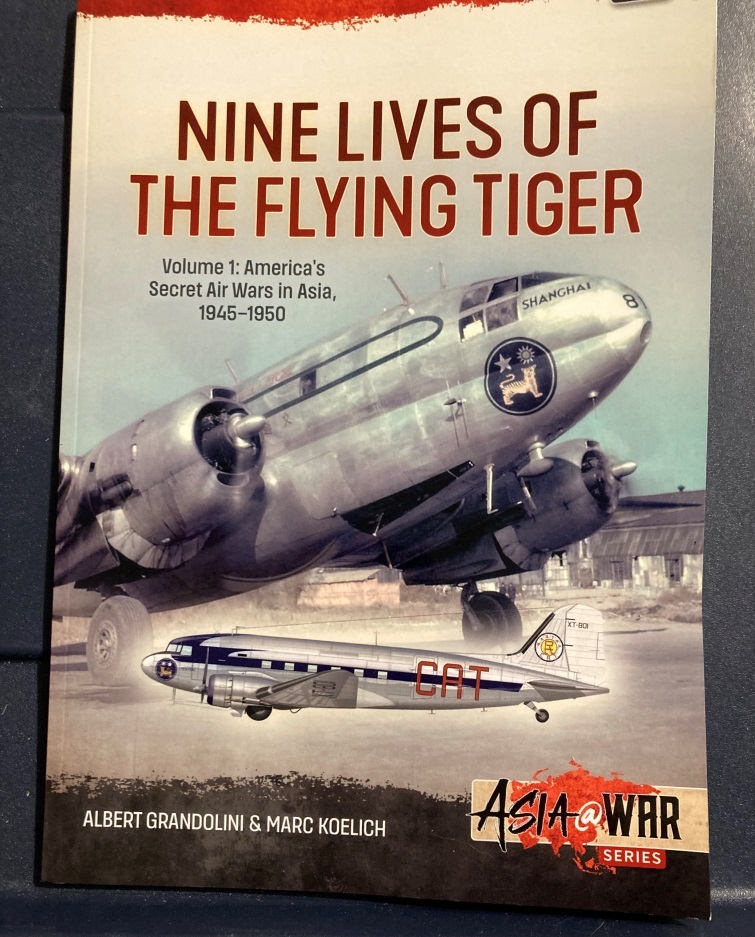Nine Lives of the Flying Tiger (Asia at War series #43)
Here is the overview from Casemate’s website:
The famed American Volunteer Group (AVG) created in August 1941, under the command of Claire Lee Chennault set an example of heroism for the American public opinion at the onset of the Second World War. This band of volunteer aviators serving under the Chinese Government tried to stem the tide of the Japanese onslaught throughout Southeast Asia. Amid chaos and resounding defeats of the Western powers in the area, the AVG fought tenaciously against the Japanese. Highly publicized in the US as the Flying Tigers, the AVG set up the origin and legacy of further United States clandestine air wars in Asia, and elsewhere in the world in the coming decades. From that point on, the name of Claire Lee Chennault was associated with paramilitary and secret air operations on behalf of the United States Government in Asia. However, if his involvement in China in late 1930s is well documented, his involvement in various clandestine air operations after the Second World War is far less well known.
Far from the image of a lonesome maverick often portrayed, Chennault was right from the start closely in contact with the US intelligence services and, with the support of the US presidency, developed plans to wage a secret air war against Japan. After the Second World War, he returned to China to create the Civil Air Transport (CAT), an airline originally involved in refugee relief missions but that was soon caught in the Chinese civil war where CAT was quickly involved in paramilitary operations, flying troops and supplies to supplement the Chinese Nationalist Air Force. Despite the dedication of the CAT personnel, the Nationalists suffered a series of disastrous defeats, and the remnants of their forces withdrew into Taiwan. The near-bankrupt CAT found a last-minute investor, the newly-created US Central Intelligence Agency (CIA), which purchased CAT for its clandestine operations in Asia in this nascent Cold War period. Officially a Taiwanese airline that ran regular commercial operations, the CIA was also running a discrete paramilitary department that was engaged in numerous clandestine air operations until the early 1960s when it was rechristened as Air America.
This first volume covers the birth of CAT and its involvement in the Chinese Civil War up to the Nationalist withdrawal to Taiwan.
There are a total of 21 chapters in this book; filled with pictures most of us may have never seen, it highlights much of a part of the world either neglected or relegated to secrecy.
Filled with photos I had never seen before, as well as du rigeur color profile images (which are very well done, tonal effort is more photographic than seen in many recent books), makes the book acquisition worthwhile alone for the modeling reference to the early Chinese Air Forces.
The narrative is excellent and well-researched. One thing I found interesting: The Curtiss P-40B/C’s (Properly Curtiss Wright H81-A2) used by the Flying Tigers in World War II were a manufactured production run of their own and not “cast off” items from the UK during lend-lease as many have stated in the past. Britain had decided to purchase later “D” models after purchasing the original production series, and 100 of the earlier models were partially complete at the time of the change… The final designation was H81-A3 to differentiate from the A2 British aircraft. Pg. 20 in the book goes over the story. All these years and things I didn’t know. (Sidebar: Reminds me of the erroneous thought the KC-135 was an airliner derivative…Nope, ‘135 was first, a direct descendant of the Boeing Dash 80, not the later airliner. There are pix of the boom on the -80. The late Boeing Expert, one each Al Lloyd and I had many discussions on this back in 2005-6 when we were developing supporting narratives the ‘135’s 50th anniversary celebration for the AF) I truly miss him, he was a library of Boeing Aviation in one place.
This book goes into the buildup and development of the Chinese/Japanese conflict in detail, and in particular the commander of that unit, Chennault, concerning his involvement.
Knowing full well of the political landscape inherent in the military at higher echelon, the ability of Col. Chennault (later Lieutenant General) is a classic case of how to get things done even if political expediency is against you. It also helps to have a President on your side…
Development of the “pre-radar” early warning system for the Chinese against Japanese bombing raids was expounded on in detail… an excellent example of people rising up to a situation and excelling through technology, even in a locale as large as China proper.
Much of the rest of the book goes over the expansion of the Chinese Air Force, and the implications of Communist and Russian efforts in the conflict.
I also enjoyed the observation by the authors on page 8, paragraph 2 about Chennault, where they went into one detail and concluded with something overlooked frequently by so many people who are guests overseas: “… He was also extremely comfortable with the Chinse culture; a trait well appreciated by his Chinese counterparts who too often had to suffer from racial superiority expressed by their Western advisors…”
A great and informative read; well researched and presented. I highly recommend this book for content.
Thanks again to Casemate for the review opportunity and to IPMS USA for trusting me to adequately do the review justice!






Comments
Add new comment
This site is protected by reCAPTCHA and the Google Privacy Policy and Terms of Service apply.
Similar Reviews